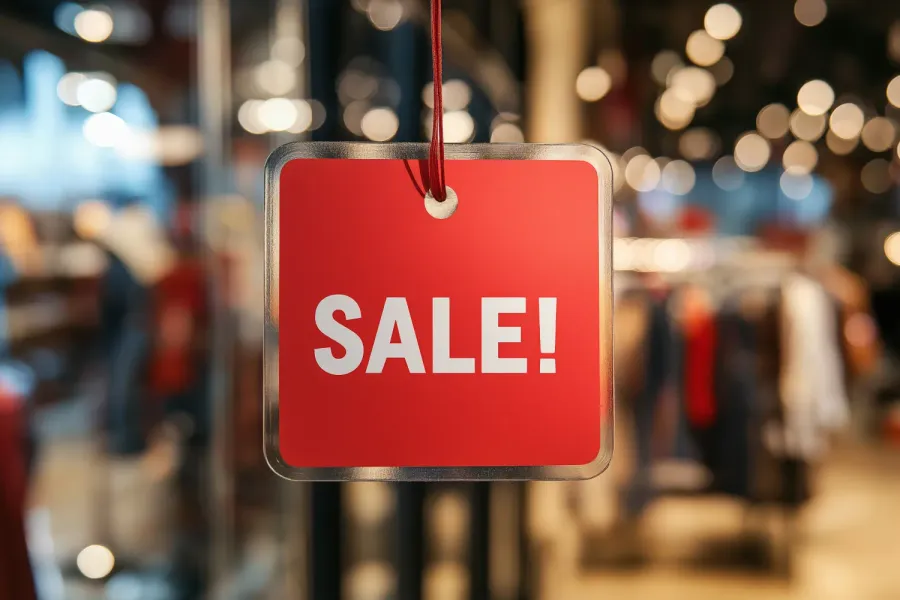
Marketing leaders know how powerful a smart sales promotion can be. These short-term incentives can range from discounts and limited-time offers to loyalty programs and product bundles.
Effective promotions can quickly boost sales, build customer loyalty, expand brand awareness, and gather market data.
This article shares 10 examples of sales promotions, from traditional coupons to innovative social media contests. Ready for ideas and techniques to build into your marketing plan? Let's dive in.
What are the most effective sales promotions?
The right sales promotion for your business will depend on your industry, audience, and marketing needs.
That said, here are 10 of the most trusted sales promotion techniques:
1. Percentage discounts
Percentage discounts offer a percentage reduction on the original price of a product or service. They're easy to understand and can be applied broadly across product lines, creating a sense of urgency and encouraging purchases.
For a real-world example, consider clothing retailers, which frequently offer percentage discounts on select styles, both in-store and online.
To make the most of percentage discounts, ensure your promotion is significant enough to motivate action but not so high that it devalues your product. Also, clearly communicate the discount's terms and duration.
2. Buy-one-get-one (BOGO) offers
BOGO offers give customers a free or discounted item when purchasing a specific product. These promotions provide additional, perceived value and can help move excess inventory quickly.
Try to choose complementary products for your BOGO offers. Clearly state any restrictions on the free or discounted item and consider your profit margins to ensure the promotion continues to benefit your bottom line.
3. Loyalty programs
Loyalty programs offer points, discounts, or exclusive perks to repeat customers. These rewards programs encourage repeat business and can increase customer lifetime value.
For example, Starbucks Rewards offers free drinks, personalized offers, and exclusive access to new products.
When developing a loyalty program, make it easy to understand and use. Offer meaningful rewards that align with customer preferences and use data to personalize offers and improve the customer experience.
4. Flash sales
These short-term, high-discount promotions last for a few hours or days. Flash sales create urgency and encourage immediate action from customers.
Consider Amazon Prime Day, which offers limited-time deals exclusively for Prime members. This event often increases sales volume so dramatically that discounted prices can be easily offset.
Promote your sale in advance to build anticipation. Ensure your website can handle increased traffic and offer genuinely attractive deals to maintain customer trust.
5. Free shipping
Next, consider waiving shipping costs for orders that meet certain criteria. Free shipping can reduce cart abandonment and encourage larger purchases.
It's considered best practice to set a reasonable minimum order value when you can. Additionally, clearly communicate restrictions or exclusions. You can also consider offering expedited shipping options at a discounted rate.
6. Product bundling
Product bundling involves combining multiple products or services into a single package at a discounted price. Bundling can increase average order value and help sell less popular items alongside bestsellers.
Ensure your bundled products complement each other and price the bundle attractively compared to individual item prices.
7. Referral programs
Referral programs are designed to reward existing customers for bringing in new ones. They leverage word-of-mouth marketing and can help you acquire new customers at a lower cost.
When developing a referral program of your own, make the referral process as simple as possible. Offer rewards that benefit both the referrer and the new customer. Track and analyze referral data to optimize the program.
8. Seasonal promotions
These are special offers tied to holidays, seasons, or events. These promotions should align with customer buying patterns and can create a sense of tradition. For example, Nordstrom's Anniversary Sale — held annually in July — offers new fall pieces at discounted prices without competing with other seasonal deals.
To implement this strategy, plan well in advance. Tailor your offers to the season or event and create a sense of anticipation through pre-promotion marketing.
9. Social media contests
These promotions encourage engagement on social platforms, often requiring users to like, share, or create content. Social media contests can increase brand visibility and engagement at a relatively low cost.
Always keep entry requirements simple. Ensure the prize is relevant to your target audience and follow platform-specific rules.
10. Limited-time free trials
Finally, consider offering a product or service free for a limited time, allowing customers to experience its benefits. These free trials reduce perceived risk and can lead to long-term subscriptions or purchases.
Make your sign-up process easy, but payment information should still be required to streamline conversions. Send reminders before the trial ends, and provide excellent service during the trial to boost retention.
What is the role of technology in sales promotions?
Technology is integral to making sales promotions work. Advanced analytics tools help businesses target promotions more precisely, while automation can make executing and streamlining promotions easier than ever.
That said, your tech must align with your overarching business goals. For instance, choose services that meaningfully measure the key performance indicators (KPIs) that matter to your business and reflect your objectives, such as conversion rates, customer lifetime value, or return on investment.
Some common pitfalls include over-relying on technology without a solid strategy, neglecting data privacy concerns, and failing to integrate your promotional efforts across multiple channels. By leveraging technology thoughtfully and strategically, businesses can significantly boost the impact of their sales promotions.
The bottom line
Strategic promotions can support your bottom line, whether by attracting new customers or increasing sales. That said, remember to set clear goals, choose the right promotion type, and measure your results.
Superhuman is the most productive email app ever made. Fly through your inbox twice as fast and save more than four hours every single week.
Sign up for Superhuman today.




